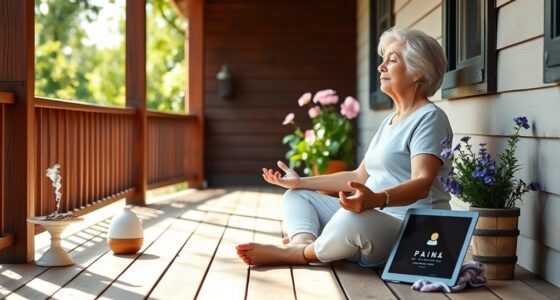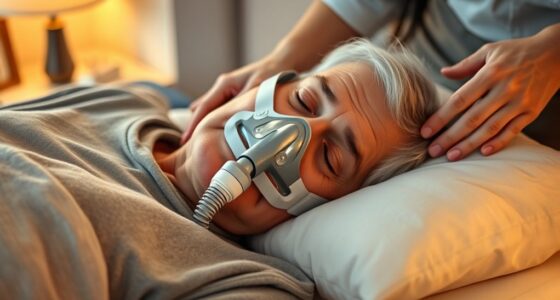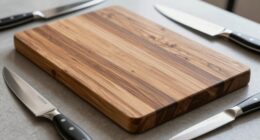To make dressing easier with arthritis, you can use adaptive tools like magnetic closures, Velcro fasteners, zipper pulls, and button aids that require less grip strength. Sock and stocking helpers, long-handled dressing sticks, and shoehorns make donning clothes and shoes simpler. Elastic laces and slip-on shoes reduce the need for tying, while reachers help you manage clothing without bending. Keep exploring to find the best solutions to make dressing more comfortable and independent.
Key Takeaways
- Magnetic closures, Velcro fasteners, and elastic waistbands simplify dressing by replacing buttons and zippers, reducing fine motor demands.
- Long-handled aids, zipper pulls, and sock helpers assist with donning clothing and footwear without bending or twisting.
- Slip-on shoes, elastic laces, and shoehorns enable easier footwear management, minimizing the need for tying or bending.
- Reachers, dressing sticks, and ergonomic tools help extend reach and reduce effort during dressing tasks.
- Selecting lightweight, easy-to-grip, and adjustable devices enhances independence and comfort for individuals with arthritis.
Easy-to-Use Dressing Aids for Upper Body Clothing

For individuals with limited mobility or dexterity, dressing upper body clothing can be challenging. Using simple dressing aids makes the process easier and less frustrating. Tools like long-handled zipper pulls allow you to close zippers without struggling. Sock and shoe assist devices help you put on footwear with minimal bending or twisting. Button hooks make fastening buttons more manageable, especially if gripping is difficult. Elastic shoelaces turn laces into slip-on solutions, saving time and effort. Clothing hooks and magnetic closures replace traditional fasteners, reducing the need for fine motor skills. These aids are lightweight, easy to grip, and designed for comfort. They give you more independence and confidence, simplifying dressing routines and reducing discomfort caused by arthritis or limited hand strength. Additionally, understanding how contrast ratio influences image quality can help you select clothing or accessories with better visibility and easier handling. Improving visual contrast can make it easier to distinguish clothing fasteners and improve overall accessibility. Paying attention to ergonomic design in assistive tools can further enhance comfort and ease of use during dressing activities.
Adaptive Sock and Stocking Helpers

Adaptive sock and stocking helpers make putting on and taking off easier, especially if mobility is limited. They guarantee a secure fit that stays in place comfortably throughout the day. With these tools, you can enjoy hassle-free dressing and reliable comfort. Incorporating specialized aids for dressing can further enhance independence and ease of use. Additionally, using self-watering plant pots can reduce the need for frequent watering chores, making daily routines more manageable. Recognizing benefits of glycolic acid that suit your pet’s personality can also contribute to a more enjoyable and personalized experience. Implementing privacy policy considerations ensures your personal data remains protected while accessing these helpful products.
Easy Donning and Doffing
Easy donning and doffing can be a challenge, especially for individuals with limited mobility or dexterity. Adaptive sock and stocking helpers simplify this process by reducing the effort needed to put on or take off clothing. These tools often include devices like long-handled aids or slip-on assistors that help you slide socks or stockings without bending or straining. Using these tools saves time and minimizes frustration, making dressing more manageable. Here’s a quick comparison:
| Tool Type | How It Works | Benefits |
|---|---|---|
| Sock Aids | Guides socks onto foot | Reduces bending, easier use |
| Stocking Donners | Holds stockings open | Easy to slide over leg |
| Long-Handled Aids | Assist in pulling clothing | Less strain, more independence |
These tools give you confidence and control, making dressing less stressful.
Secure Fit and Comfort
When choosing sock and stocking helpers, making certain a secure fit and supreme comfort is essential for effective use and wearer satisfaction. A well-fitting aid prevents slipping or bunching, reducing frustration and potential skin irritation. Look for tools with adjustable features or stretchable materials that conform to your leg’s shape. Soft, breathable fabrics help prevent chafing and keep your skin comfortable throughout the day. Proper fit also provides added confidence, knowing your socks stay in place. Avoid stiff or restrictive designs that may cause discomfort or restrict circulation. The right helper should feel snug without being tight, offering support while allowing ease of movement. Prioritizing fit and comfort ensures that your dressing routine remains stress-free and that your legs stay comfortable all day long.
Simplified Fastening Devices for Shirts and Pants
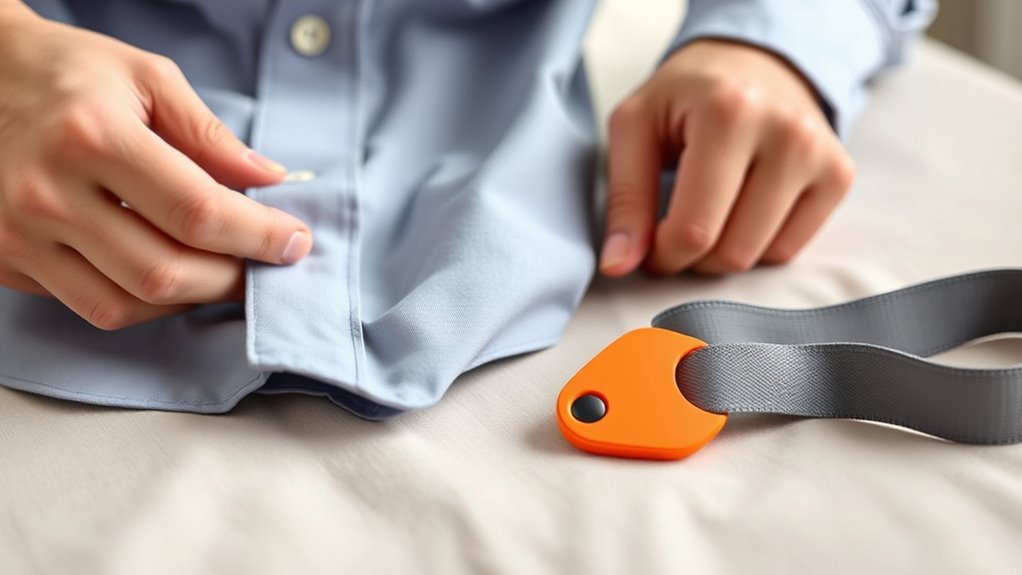
Simplified fastening devices for shirts and pants are transforming how you get dressed if you struggle with limited dexterity. These tools make fastening easier, reducing frustration and saving time. Here are four options you might find helpful:
- Magnetic shirt closures that replace buttons with powerful magnets.
- Velcro fasteners for pants and shirts, offering quick and secure fastening.
- Elastic waistbands that stretch for easy pull-on comfort.
- Snap closures designed to mimic buttons but require less effort to fasten.
These devices help you dress independently, boosting confidence and comfort. They’re simple to use and adaptable for various clothing styles. By minimizing the effort needed to fasten clothing, you can focus more on your day and less on struggle. For individuals with conditions affecting finger dexterity, such as dog breeds known for high intelligence and adaptability, these tools can be especially beneficial. Incorporating adaptive clothing technology into your wardrobe can further enhance ease of dressing and independence. Additionally, these innovations are part of assistive devices that support everyday activities. Understanding the underlying narcissistic traits can also help caregivers and loved ones provide better support and encouragement during the rehabilitation process. Moreover, utilizing remote collaboration tools during the development of adaptive clothing can foster innovative solutions through diverse team input.
Innovative Zipper Pulls and Button Aids

Building on the benefits of simplified fastening devices, innovative zipper pulls and button aids offer even greater independence for those with limited dexterity. These tools are designed to make zippers and buttons easier to manage, reducing frustration and strain. Zipper pulls attach securely to existing zippers, providing a larger, easier grip that requires less strength to operate. Button aids often feature enlarged, textured surfaces or looped handles that let you grasp and manipulate buttons more easily. With these tools, you can zip and button clothing without needing fine motor precision. They’re portable, simple to use, and compatible with most clothing items. By incorporating zipper pulls and button aids into your routine, you gain more control and confidence when dressing, making daily tasks smoother and less painful.
Assistive Tools for Shoes and Footwear

Assistive tools for shoes and footwear can make dressing easier and safer. You might find slip-on devices, adaptive lacing systems, or non-slip aids helpful for everyday use. These tools provide support and independence when putting on or taking off shoes. Incorporating best product recommendations can further enhance ease of use and comfort. For added effectiveness, choosing tools that contain beneficial ingredients like collagen and hyaluronic acid can also support skin health around the feet and ankles. Additionally, integrating automation in healthcare can lead to more personalized assistive solutions and improve overall mobility support. Leveraging the power of imagination can inspire innovative approaches to adaptive dressing solutions that blend style with practicality. Understanding celebrity lifestyle insights can also motivate the adoption of fashionable yet functional footwear options.
Easy Slip-On Devices
Easy slip-on devices are practical tools designed to help you put on shoes quickly and effortlessly. They eliminate the need to bend or struggle with laces, making dressing easier. These devices are especially helpful if you have arthritis or limited hand strength. Here are some popular options:
- Shoe Horns – Long-handled tools that help slide your foot into shoes without bending.
- Sock Assist Devices – Help you put on socks with less effort.
- Elastic Shoe Laces – Replace traditional laces for a quick slip-on experience.
- Slip-On Shoes – Designed without laces or fasteners for easy wearing.
With these tools, you’ll find putting on shoes faster, less painful, and more comfortable.
Adaptive Lacing Systems
Adaptive lacing systems are innovative solutions that make securing your shoes simpler and more convenient. With these systems, you can easily tighten or loosen your footwear without tying traditional laces. Many designs feature one-handed operation, allowing you to adjust your shoes quickly, even if you have limited hand strength or dexterity. Some systems use pull cords, locking mechanisms, or elastic laces that adapt to your foot’s shape for a snug, comfortable fit. They eliminate the need for constant re-tying, saving you time and reducing frustration. Adaptive lacing systems are especially helpful if you struggle with traditional laces due to arthritis or mobility challenges. By providing a secure fit with minimal effort, these tools help you maintain independence and confidence when dressing.
Non-Slip Shoe Aids
Non-slip shoe aids are essential tools that help you stay steady and prevent falls when walking on slippery or uneven surfaces. These aids improve traction and give you confidence with each step. Here are four popular options:
- Rubber Sole Grips – Attach to your shoes for extra grip on slick surfaces.
- Non-Slip Shoe Pads – Stick inside your shoes to prevent slipping inside.
- Shoe Traction Cleats – Wear over your shoes for enhanced grip outdoors.
- Slip-Resistant Shoe Socks – Provide added traction and comfort.
Using these aids can markedly reduce your risk of falls and help you maintain independence. They’re easy to use, affordable, and compatible with most footwear. Incorporate them into your daily routine to walk with confidence, even on challenging surfaces.
Dressing Sticks and Reachers for Accessibility

Dressing sticks and reachers are essential tools that help individuals with limited mobility dress more independently. They extend your reach, allowing you to grab clothing, socks, or accessories without bending or straining. With a dressing stick, you can easily pull up your pants or shirt, while reachers help you pick up dropped items or reach for clothes on higher shelves. These tools are lightweight, easy to grip, and designed for comfort, making dressing routines less frustrating. By reducing the need for bending or stretching, they minimize pain and fatigue. Whether you’re struggling with arthritis or limited flexibility, dressing sticks and reachers give you more control and confidence in your daily dressing tasks. They’re simple yet effective aids to support your independence.
Magnetic Closures and Velcro Alternatives

Are traditional fasteners like buttons and zippers becoming a challenge? Magnetic closures and Velcro alternatives can simplify dressing and reduce frustration. These options are easy to use, quick to secure, and gentle on sensitive skin. They’re especially helpful if you struggle with fine motor skills or arthritis pain. Here are four benefits:
- No fiddling with tiny buttons or zippers
- Secure hold with minimal effort
- Faster dressing process
- Less strain on fingers and hands
Magnetic closures snap into place effortlessly, while newer Velcro alternatives offer quiet, smooth fastening. These tools make dressing less frustrating and more independent, helping you maintain comfort and confidence throughout your day.
Hands-Free Dressing Solutions

Hands-free dressing solutions make independence easier by providing easy-access fasteners and automated assistance. These tools allow you to dress without needing to manually manipulate traditional fasteners or rely on help from others. They’re designed to streamline the dressing process and boost your confidence. Incorporating adaptive culinary tools can also make preparing meals more manageable, enhancing overall independence.
Easy-Access Fasteners
For individuals with limited mobility, easy-access fasteners provide a practical solution to simplify dressing. These fasteners reduce the need for fine motor skills and help you get dressed more independently. They come in various forms, making clothing easier to manage. Here are four popular options:
- Magnetic buttons – Replace traditional buttons with magnets that snap together effortlessly.
- Velcro straps – Offer quick fastening and unfastening, ideal for shoes and closures.
- Hook-and-loop fasteners – Provide adjustable, secure closures for various garments.
- Elastic waistbands – Eliminate the need for fasteners altogether, making pants easier to slip on and off.
These solutions help you dress more comfortably and with less frustration, promoting independence and confidence.
Hands-Free Assistance
Have you ever wished dressing could be completely effortless? Hands-free dressing solutions make that possible. With devices like long-handled tools, zipper pulls, and sock aids, you can manage your clothing without straining your hands or arms. These tools help you reach, pull, and adjust clothing while reducing the effort needed. For example, a dressing stick allows you to pull up pants or fasten buttons without bending or stretching too much. Sock aids help slide socks on smoothly, eliminating the need for complex movements. By using hands-free solutions, you gain independence and save energy, making daily dressing less frustrating and more manageable. These tools are simple yet powerful in helping you stay comfortable and confident in your routine.
Adaptive Clothing Options for Ease and Comfort
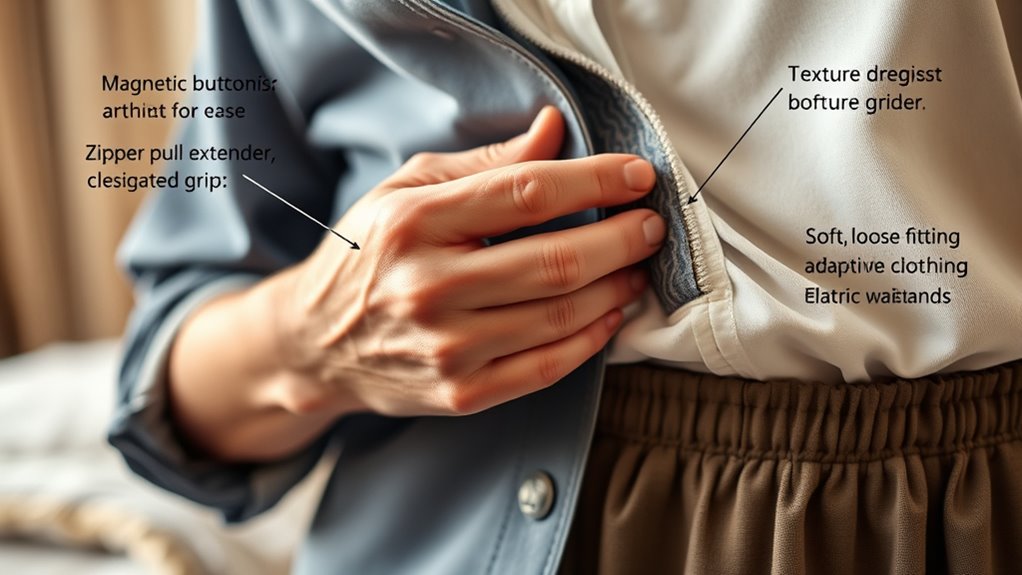
Adaptive clothing options prioritize ease and comfort by incorporating features like magnetic closures, elastic fabrics, and adjustable designs. These innovations help you dress more independently and comfortably, reducing frustration and strain. Here are some popular choices:
- Magnetic-button shirts and pants that eliminate the need for fine motor skills.
- Elastic waistbands for quick, secure fit without zippers or buttons.
- Velcro-fastened shoes that are easy to secure and remove.
- Wrap-around or loose-fitting tops that slide on easily without pulling over your head.
These options make dressing simpler and more comfortable, allowing you to focus on your day instead of struggling with clothing. Adaptive clothing is designed with your needs in mind, providing freedom and confidence.
Tips for Choosing the Right Dressing Aids

Choosing the right dressing aids can make a significant difference in your daily routine by enhancing independence and comfort. Start by evaluating your specific needs—consider which tasks are most challenging, like buttoning shirts or tying shoelaces. Look for tools that are easy to grip and operate, such as long-handled shoehorns or zipper pulls. Ensure the aids are adjustable or versatile enough for different clothing types. Prioritize comfort and ease of use, avoiding devices that are bulky or complicated. Read reviews and ask for recommendations from healthcare providers or support groups. Remember, the best dressing aids fit seamlessly into your routine and reduce strain, helping you maintain your independence with confidence. Assistive technology continues to evolve, offering more tailored solutions for individuals with arthritis.
Frequently Asked Questions
Are These Adaptive Tools Suitable for All Types of Arthritis Severity?
You wonder if adaptive tools suit all arthritis severities. While these tools can help many, they might be more beneficial for mild to moderate cases. If your arthritis is severe, you may need more specialized equipment or assistance. It’s best to consult your healthcare provider to determine which tools fit your specific needs. Remember, the goal is to make dressing easier without causing discomfort or further strain.
Can These Dressing Aids Be Used Independently Without Assistance?
Think of dressing aids as your personal toolkit, ready to help you regain independence. Yes, you can often use these aids without assistance, turning a challenging task into a manageable one. They are designed to be user-friendly, allowing you to grasp, pull, and fasten with less effort. With a little practice, you’ll find these tools empowering, transforming dressing from a struggle into a smooth, solo routine.
What Safety Features Should I Look for in Adaptive Dressing Tools?
When choosing adaptive dressing tools, you should look for safety features that guarantee ease of use and prevent accidents. Check for non-slip grips to maintain control, rounded edges to avoid cuts, and secure fasteners that won’t come loose easily. Additionally, opt for lightweight, ergonomic designs that reduce strain and allow you to adjust or operate the tools comfortably. These features help you stay safe and confident while dressing independently.
Are There Specific Brands Recommended for Durability and Effectiveness?
You might worry about finding reliable brands, but rest assured, several stand out for durability and effectiveness. Look into brands like EZ-On, Dressing Stick, and Button Hook, which are highly recommended by users with arthritis. These brands focus on quality, ease of use, and long-lasting materials. Choosing reputable names guarantees you get tools that truly make dressing easier, helping you maintain independence with confidence and comfort.
How Do I Maintain and Clean These Adaptive Dressing Devices?
You wanna keep your adaptive dressing tools in good shape, so check the manufacturer’s instructions first. Usually, you should clean them regularly with mild soap and water, avoiding harsh chemicals. For devices with metal parts, dry them thoroughly to prevent rust. Store them in a dry, cool place when not in use. Regular maintenance guarantees they stay effective and last longer, making dressing easier each day.
Conclusion
With the right range of reliable, user-friendly tools, dressing becomes less intimidating and more doable. By exploring adaptive aids, you’ll find freedom from frustration and fuss, fostering confidence with each step. Simplify your style, secure your comfort, and support your independence. Remember, choosing the right dressing devices makes daily dressing a doable, delightful, and dignified daily routine. Embrace these aids, and enjoy easier, empowering everyday dressing!


